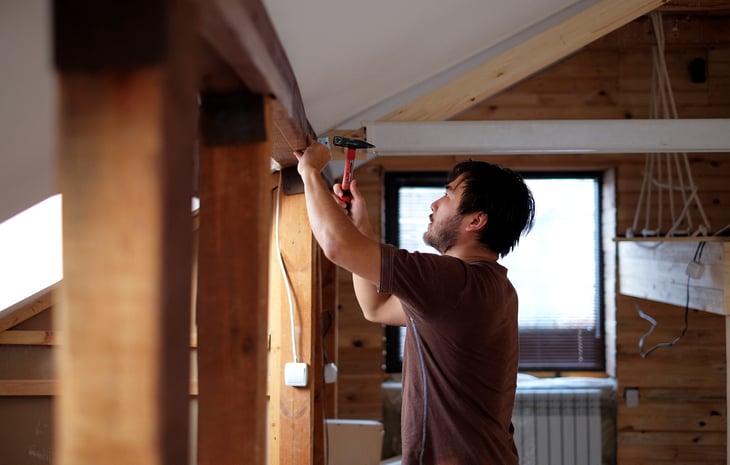
Editor's Note: This story originally appeared on Point2.
Whether you’re just moving into your first home or flipping an investment property, there’s a good chance that, at some point, you’ll need to carry out home renovations.
When they’re done right, the final result can be fantastic, transforming a house into a home. Get it wrong, however, and you could be left living in a construction site and struggling to pay the bills.
Fortunately, with careful planning, your home renovation can be completed on time and within budget. In this guide, we’ll discuss the steps you need to take while looking at a few tips and tricks to ensure the whole process runs smoothly.
6 Things to Do Before You Start Renovating

The success of your home renovation projects largely depends on how much effort you put into planning them. The worst thing you can do is leave everything to the last minute and hope for the best.
Instead, follow these steps to make sure your renovations succeed.
1. Research Your Project

Before you do anything else, it’s essential to conduct basic research into what you plan to do.
For example, if you’re planning to remodel your bathroom and wish to change the layout, you’ll need to know how much work is involved, how much it’s likely to cost, and whether you need any permits.
During your research, you should also determine if it’s a project you can DIY or one for professionals.
2. Make a Solid Plan

Having researched the viability of your renovation, you’re ready to start drafting a plan of action. It’s essential to take your time to create a solid plan of what you aim to do, detailing the following:
- Time frame
- Accurate measurements of the work area (particularly important if you’re painting or laying new flooring)
- The materials you plan to use
- Any particular colors and finishes
- Appliances and other products or features you’d like to buy
- Your budget
If you plan to work with a general contractor, this plan will be invaluable to ensure everyone is on the same page. Depending on the size and scope of your renovation, you may also need to draw up blueprints.
Finally, organize the work order, especially if you’re renovating more than one room. It can help to split the work up and focus on one area at a time rather than turning your entire home into a construction site, particularly if you’ll be living on-site during the renovation.
3. Create an Accurate Budget

With a solid idea of what you want to do, it’s time to focus on your budget. It’s always worth spending a little more to complete the job correctly, so if the funds aren’t quite there yet, you might want to delay a little.
When creating a budget, make sure to factor in the following costs:
- Materials
- Labor
- Appliances and products
- Tools or tool hire (if DIYing)
- Permits (if necessary)
Beyond these somewhat obvious elements to budget for, there are several other things to consider. For example, if you’re planning to move out during renovations, it’s important to add the additional cost of temporary accommodations and eating out to your budget.
To be sure you don’t miss anything, break your budget into several chunks and go through the entire renovation process from start — drawing up blueprints — to end — new furniture and appliances. If you’re unsure about anything, get advice from a friend or family member who has been through a similar process or a professional.
4. Speak With a Reliable Contractor

Working with a contractor is never a bad idea when tackling more extensive home renovations. Of course, you may choose to carry out the upgrades yourself, but even if that’s the case, you could still benefit from discussing your project with a professional. They can give you a better idea of the best materials to use, whether your budget is accurate, and how long things will take.
If you’re looking to hire a general contractor for the job, be sure to take your time and research various candidates. Ideally, you’ll find a general contractor with relevant experience, excellent references, and, most importantly, one you’re comfortable working with. When you find such a person, here are a few questions to ask them:
- Are my plans realistic? A professional contractor will always notice details that you’ve potentially missed during the planning stage. As such, they can advise as to whether your plans are achievable or not. If you have made a mistake, a good contractor will help you develop a more viable solution.
- Is my budget adequate? As well as being physically viable, it’s essential that your plans are financially doable, too. A good contractor will review your budget and let you know if you’ve put enough aside to do the job correctly. Often, they’ll also help you find ways to bring the costs down while maintaining quality.
- How long will the project take? An accurate timeline is essential when it comes to home renovations. A good contractor can give a far more precise estimate of how long things will take based on their experience.
If you choose to work with the contractor, it’s also important to discuss the payment schedule. Typically, you’ll be expected to pay around 10% of the cost upfront on a large project, followed by a set number of periodic payments until the work is complete.
Once you’re happy with everything, be sure to get it all in writing — before work commences, you should have a detailed contract drawn up. This should cover everything from the cost and time frame to dispute resolution and materials.
5. Select Your Materials

One major cause for delays on larger renovation projects is the failure to source the desired materials and products.
It can take a lot of time to order certain items and have them delivered, especially bespoke items. If that happens, you may find yourself settling for second best after rushing to make a decision under pressure.
This can be avoided by making your decision before work begins and ensuring that the materials and products you want are in stock and can be delivered in a timely manner.
That’s not to say that you can’t change your mind about specific pieces of furniture and other fittings as work progresses, but for those items that can take a long time to arrive, it’s best to get them ordered in plenty of time.
6. Figure Out Financing

With everything in place, the final thing to work out before the project can begin is how you’ll finance the work. This isn’t such a big issue for smaller renovations, but for larger projects, there’s a good chance you’ll need to take out a loan. Fortunately, when it comes to financing your home renovations, you have several choices.
- HELOC: A home equity line of credit (HELOC) is a popular way to cover renovation costs using the equity you’ve already built in your home. Working similarly to a credit card, you can withdraw as little or as much as you need during the draw period, making it a flexible option ideal for those unexpected costs.
- Home Equity Loans: This is an excellent choice if you need a large, lump sum payment to cover significant renovations and repairs. Like a HELOC, it taps into your existing equity, which must be at least 20%.
- Cash-Out Refinancing: Ideal for large projects, such as expansions, cash-out refinancing is best for those with a lot of equity in their home. This low-interest loan is more suitable for those who aren’t looking to sell their house any time soon.
- Credit Card: You don’t need to tap into your home equity to fund your renovations. A regular credit card is a good choice for smaller projects.
- Government-Backed Loans: It’s always worth checking to see if there are any local government-backed loans or schemes that you might qualify for. In the U.S., for example, there are several Federal Housing Administration (FHA) loans designed to fund home renovations. Meanwhile, the Canada Greener Homes Loan is aimed at those who wish to make their homes more energy-efficient.
10 Home Renovation Tips for a Stress-Free Project

With the planning phase out of the way, the work can soon begin. But, as your home gets turned upside down during the upgrade, it can quickly become stressful.
With that in mind, here are a few tips and tricks to help your home renovations go smoothly.
1. Stick to a Daily Plan

Break your renovation project up into smaller chunks and create a daily plan. Not only will this give you a better idea of how long everything will take, but it’ll also give you a heads-up as to what to expect each day.
2. Make Time for Yourself

When making your daily plan, be sure to set aside a little time for yourself each day. Try to limit the time you spend renovating to a set number of hours you’re comfortable with.
When you’ve reached your quota, drop tools and take some time to relax. It’s easy to work for far too long, which tends to be when mistakes happen.
3. Prepare Before the Work Begins
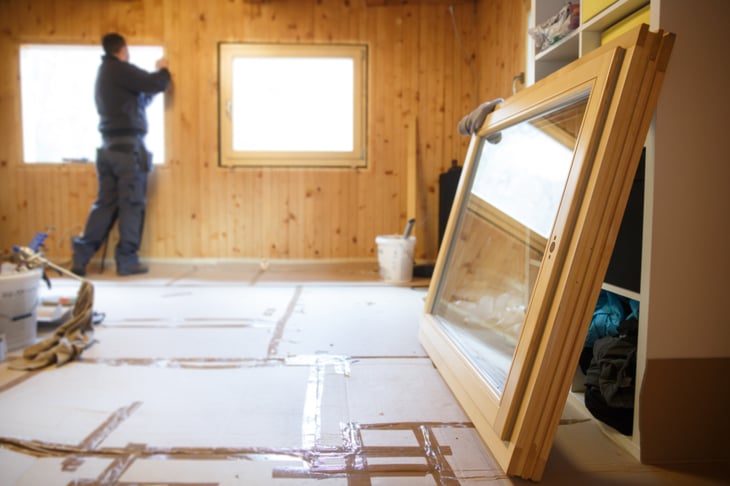
Whether hiring contractors or doing the work yourself, it’s good to prepare the work area in advance. Clear out the relevant rooms and clean whatever needs cleaning.
This way, you can put your things away tidily rather than having your items removed and stuffed away at the last minute.
4. Use Self Storage

For ultimate peace of mind, consider storing things like clothes, furniture and even kitchen utensils in a storage unit. For larger projects, this can really help free up space.
Even better, by keeping them off-site, they’re safe from construction dust, paint, and other things that could damage them while your home reno is underway.
5. Stick to Your Budget

Financial woes are a cause of stress during any renovation. Even with an accurate budget, unexpected costs can be worrisome.
To combat this, here are a few tips and tricks.
Allow a Little Extra

Always allow an extra 10% or 15% on your budget to cover unexpected costs and additional fees associated with the inevitable delays you might come across.
Anything from discovering asbestos or outdated wiring to material shortages can lead to increased costs and delays, so it’s always good to have some cash at hand, just in case.
Don’t Go Overboard

It’s tempting to overdo your renovations, but if you plan to flip a property, it’s not always a good idea. Knowing your market is essential.
For example, you’ll struggle to make back your investment if you fit a gourmet kitchen in a midrange neighborhood. Often, it’s better to go midrange rather than all-out.
For homeowners not looking to sell, it’s also wise to hold fire and save some cash for the rest of the house.
Stick to Your Original Plan

One surefire way to go over budget is to deviate from your original plan. Making last-minute decisions under stress will often result in overspending.
Instead, stick to your original plans as much as possible and avoid getting sidetracked. This way, you can anticipate problems in advance and account for them.
6. Create a Haven for Yourself

Extensive home renovations can see your home become a construction site for weeks. In an ideal world, you might move out during this time, but that incurs extra costs and isn’t always a practical solution.
So, if you need to live on-site during the work, designate a part of the house you can retreat to, away from the renovations. This could be your bedroom or a spare room, for example. Wherever it is, just be sure it allows you to continue your daily routine as much as possible, especially if you work from home.
7. Treat Yourself to Take-Out

Renovations are hard work, even if you’ve hired professionals to carry them out. Chances are, you won’t feel like cooking much if your kitchen is in disarray. Ordering take-out allows you to relax a bit rather than stressing out about meal prep, so be sure to treat yourself.
8. Let the Neighbors Know

Before you start any work, give your neighbors a heads-up, especially if the project is going to be noisy.
Have a chat with any direct neighbors and let them know the scope of the work and how long it’s due to take. This way, they’re prepared for any disturbances and are less likely to come around complaining about the noise.
9. Get Away From It All

Loud and messy, home renovations don’t give you the feeling of safety and tranquility you might expect from your home. If you can take a holiday during them, even just a few days away can be a real blessing.
However, that’s not always possible, so if you are stuck in the house and the constant hammering and drilling drive you up the wall, one easy way to relieve the stress is to get out of the house.
Perhaps go for a coffee or a nice walk to change the scenery a little bit. It can be extremely refreshing and prepare you to face the renovations again once you’ve returned. If you’re struggling to work from home during renovations, you could try a coworking office.
10. Try to Be Flexible

Even the best-laid plans can falter during the renovation process. There are many variables at any time, and it doesn’t take long for unexpected delays and extra costs to appear.
It’s essential to make peace with this from the get-go. Otherwise, you could be in for a lot of stress and worry.
When you make your initial plans, always overestimate the time it’ll take and add a little extra to your budget. That way, you should be a little more prepared for the unexpected.
9 Renovation Terms to Understand

As you plan your renovations, you’ll likely come across many acronyms and unusual phrases along the way. In this section, let’s explain some of the more common ones.
1. Blueprint
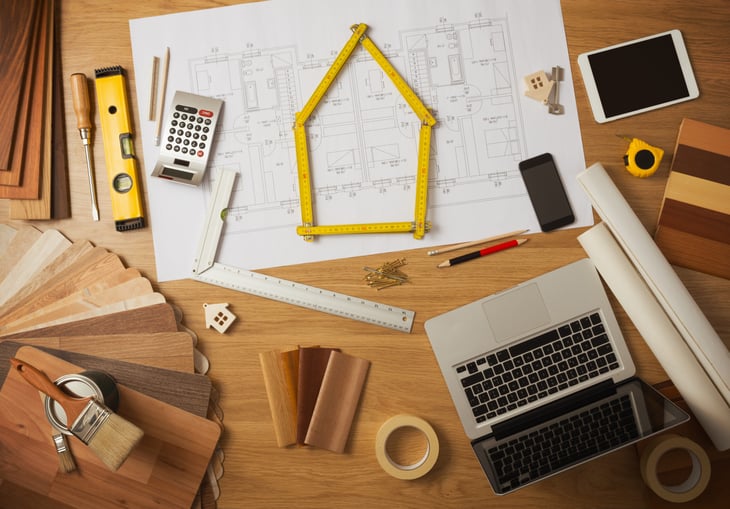
Drawn up by architects, blueprints are used to illustrate the layout of a building. The drawing highlights dimensions, access points, and much more. They’re often also known as floor plans and drawings.
2. Building Inspector

Employed by the government, the building inspector’s job is to ensure that any renovations and construction work is done to code. They’ll check that all health and safety measures are met and examine plumbing and electrical elements to ensure it’s compliant with local legislation.
On top of that, they also check that all work carried out on the building is in line with local zoning rules.
3. Building Permit

Building permits are generally required for large-scale renovations on your property, such as adding an extension. They’re granted by a local government agency and allow you to carry out the work. Work carried out without a permit can be ordered to be removed, while fines may also be given.
Not all construction work requires a building permit, but it’s a good idea to check before you begin.
4. Double-Glazed

This generally refers to a glazing system comprising two (or more) glass panes separated by inert gas or a vacuum. Double-glazed windows and doors provide far better insulation than single-pane units, reducing condensation build-up and resulting damp problems.
5. Fixtures and Fittings

A fixture describes any item in your home that is firmly fixed in place, such as toilets and chandeliers. Meanwhile, fittings tend to be easily removable, such as paintings and furniture. In renovation, the word fixture often describes things like handles, sinks, and faucets.
6. GFCI
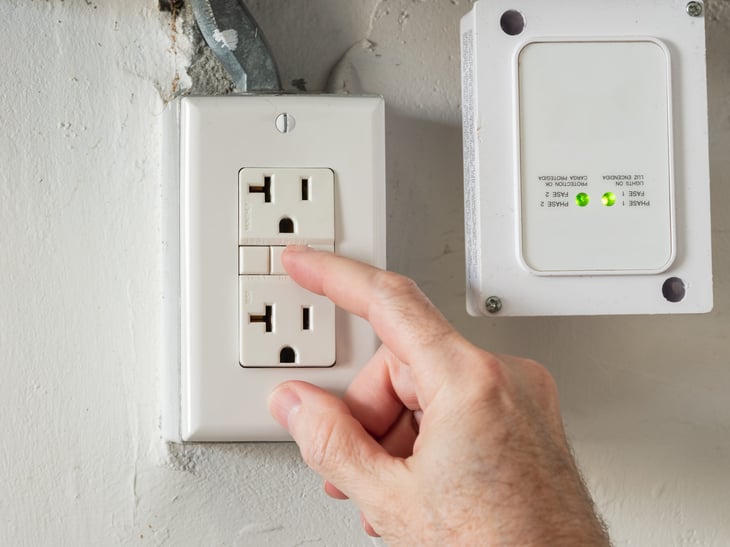
GFCI stands for “ground fault circuit interrupter.” It’s a safety device designed to break an electrical circuit in case of a fault, protecting you and others from harm.
GFCIs are typically required in areas where a water source is present, such as kitchens, bathrooms, and garages.
7. HVAC

Heating, ventilation, and air conditioning systems, aka HVAC systems, are crucial elements in many homes. They’re responsible for maintaining a comfortable temperature and humidity level and typically comprise a series of vents and heating and cooling elements.
Regular maintenance is essential and shouldn’t be neglected during renovations.
8. MDF, OSB and Plywood
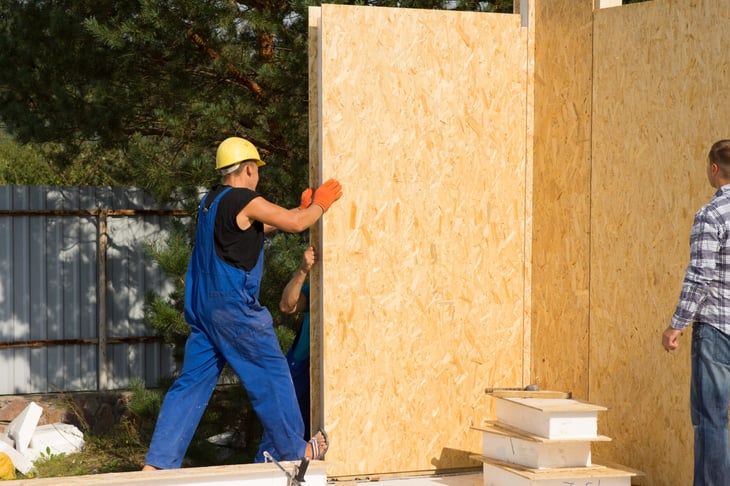
These are among the most common wood-based sheet materials you’ll come across during renovation works. MDF stands for medium-density fiberboard and is increasingly common in furniture and cabinet-making. It’s made by bonding fine wood fibers with synthetic resin adhesive, creating a dense, strong board.
OSB stands for oriented strand board and is used for various construction tasks, including flooring, loft boarding, and even furniture making. It’s a strong sheet material made with long strands of wood placed at 90-degree rotations and pressure bonded with a strong adhesive.
Plywood is similar to OSB, but rather than several smaller strands bonded together, entire wood veneer sheets are pressure bonded to one another at 90-degree rotations. They come in several thicknesses and are often used for formwork, paneling, flooring, cladding and stairs.
9. Remodeling Versus Renovation

Often used interchangeably, they don’t actually mean the same thing. Renovation typically means updating a room to change its appearance without adjusting its function. For example, repainting your bedroom would be considered a renovation.
Meanwhile, remodeling describes a more invasive process that typically involves completely remaking a room. For example, a bathroom or kitchen remodel may require adjusting the plumbing and electrical layout and adding new fixtures, tiles and flooring.
Remodeling is typically more expensive than renovating, and it’s often more likely that you’ll need to hire a professional to help. Regarding building permits, you’ll unlikely need one for renovating but might need one for remodeling projects.







Add a Comment
Our Policy: We welcome relevant and respectful comments in order to foster healthy and informative discussions. All other comments may be removed. Comments with links are automatically held for moderation.